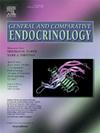Spatial and quantitative gene expression analysis of SREB receptors in the gonads of green-spotted pufferfish (Dichotomyctere nigroviridis)
IF 1.7
3区 医学
Q3 ENDOCRINOLOGY & METABOLISM
引用次数: 0
Abstract
Super-conserved Receptors Expressed in Brain (SREB) are a highly conserved family of orphan G protein-coupled receptors that consist of three members in most vertebrates: SREB1 (GPR27), SREB2 (GPR85), and SREB3 (GPR173). Each receptor is associated with diverse physiological processes and expressed in both ovaries and testes, but reproductive functions are only beginning to be understood. In addition, some fishes gained a novel fourth gene, SREB3B, which may have unique functions. The purpose of this study was to conduct a spatial and quantitative analysis of SREBs in the gonads of pufferfish (Dichotomyctere nigroviridis), which expresses all four genes. Multiplex RNAscope and absolute qPCR were used to assess gene expression patterns in both ovaries and testes. Expression was detected in early ovaries and dominated by sreb1 (approximately 2500 copies/ng RNA vs. 300 or less for others), with notable expression of all receptors in primary oocytes, granulosa cells, and small numbers of extra-follicular cells. Within primary oocytes, sreb1 and sreb3b exhibited diffuse patterns that may indicate early functions, while sreb2 and sreb3a were granular and may reflect stored mRNA. Early testicular development was dominated by sreb1 and sreb2 (∼5000 copies/ng RNA) in spermatogonia. These patterns were somewhat reduced in late testes (∼1000–2600 copies/ng RNA), but sreb3b exhibited a novel spatial pattern (∼380 copies/ng RNA) within spermatogenic cysts. These results highlight diverse roles for the SREB family, and sreb3b is hypothesized to have unique roles in fish reproduction.

绿斑河豚性腺中 SREB 受体的空间和定量基因表达分析
脑内表达的超保守受体(SREB)是一个高度保守的孤儿 G 蛋白偶联受体家族,在大多数脊椎动物中由三个成员组成:SREB1(GPR27)、SREB2(GPR85)和 SREB3(GPR173)。每种受体都与不同的生理过程有关,并在卵巢和睾丸中表达,但人们对其生殖功能的了解才刚刚开始。此外,一些鱼类还获得了第四个新基因--SREB3B,它可能具有独特的功能。本研究的目的是对河豚(Dichotomyctere nigroviridis)性腺中的 SREBs 进行空间和定量分析。使用多重 RNAscope 和绝对 qPCR 评估卵巢和睾丸中的基因表达模式。在早期卵巢中检测到的表达以 sreb1 为主(约 2500 拷贝/ng RNA,而其他基因为 300 或更少),在初级卵母细胞、颗粒细胞和少量卵泡外细胞中,所有受体都有显著表达。在原代卵母细胞中,sreb1 和 sreb3b 呈弥散状,可能表明其早期功能,而 sreb2 和 sreb3a 则呈颗粒状,可能反映了储存的 mRNA。精原细胞中的sreb1和sreb2(5000拷贝/ng RNA)在睾丸早期发育中占主导地位。这些模式在晚期睾丸中有所减少(∼1000-2600拷贝/ng RNA),但sreb3b在精原细胞囊中表现出一种新的空间模式(∼380拷贝/ng RNA)。这些结果突显了SREB家族的不同作用,并推测sreb3b在鱼类繁殖中具有独特的作用。
本文章由计算机程序翻译,如有差异,请以英文原文为准。
求助全文
约1分钟内获得全文
求助全文
来源期刊

General and comparative endocrinology
医学-内分泌学与代谢
CiteScore
5.60
自引率
7.40%
发文量
120
审稿时长
2 months
期刊介绍:
General and Comparative Endocrinology publishes articles concerned with the many complexities of vertebrate and invertebrate endocrine systems at the sub-molecular, molecular, cellular and organismal levels of analysis.
 求助内容:
求助内容: 应助结果提醒方式:
应助结果提醒方式:


